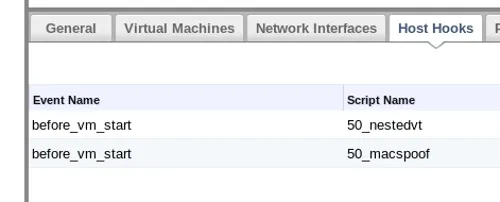We’re nearing the release of oVirt 3.3, and I’ve been testing out all the new features — and using oVirt to do it, courtesy of nested KVM.
KVM takes advantage of virtualization-enabling hardware extensions that most recent processors provide. Nested KVM enables KVM hypervisors to make these extensions available to their guest instances.
Nested KVM typically takes takes a bit of configuration to get up and running: on the host side, you need to make sure that nested virtualization is enabled, and on the guest side, you need to make sure that your guest VM’s is emulating a virt-capable processor.
With oVirt, you can take care of both the host and guest configuration chores by installing a vdsm hook on your host machine(s):
$> sudo yum install -y vdsm-hook-nestedvtDepending on your networking configuration, there’s a separate hook required to allow your nested host to pass traffic from its guests up through the machine in which it's hosted:
$> sudo yum install -y vdsm-hook-macspoofNext, you need to enable the mac-spoofing option in oVirt’s web admin console, restart the engine for that setting to take effect, and restart vdsm for the two vdsm hooks to take effect:
$> sudo engine-config -s "UserDefinedVMProperties=macspoof=(true|false)" $> sudo service ovirt-engine restart $> sudo service vdsmd restartAfter vdsm restarts, you can check to see that your hooks are installed in your host’s "Host Hooks" tab:

With the nestedvt vdsm hook installed, every guest launched from your nested-enabled hosts will inherit its own KVM-hosting capability. To enable the mac-spoofing, you have to visit the Custom Properties tab of the Edit Server Virtual Machine dialog, select "macspoof" from the "Please select a key" dropdown menu, and set the value to "true."

On my test machine, an HP ProLiant DL380p Gen8 with Sandybridge-family processors, I found that shortly after launching Fedora guest VM on my nested KVM hypervisor, the nested guest would pause and refuse to re-start. Casting about online for a solution, I found other, similar-sounding nested VM pause reports, with a suggested solution of running the problematic VMs with a earlier processor definition.
I got around this issue by changing the processor definition for my guest hypervisor from Sandybridge to Nehalem. oVirt makes this switch fairly easy — I took care of it by changing my cluster CPU type Sandybridge to Nehalem.

Nested KVM comes with a performance hit, but I’ve had no trouble testing oVirt (and other forms of KVM-based virtualization, such as OpenStack) in oVirt-hosted virtual machines.
Stay tuned for more coverage of oVirt 3.3, and be sure to follow us on Twitter at @redhatopen for news on oVirt and other open source projects in the Red Hat world.
Sobre el autor
Navegar por canal
Automatización
Las últimas novedades en la automatización de la TI para los equipos, la tecnología y los entornos
Inteligencia artificial
Descubra las actualizaciones en las plataformas que permiten a los clientes ejecutar cargas de trabajo de inteligecia artificial en cualquier lugar
Nube híbrida abierta
Vea como construimos un futuro flexible con la nube híbrida
Seguridad
Vea las últimas novedades sobre cómo reducimos los riesgos en entornos y tecnologías
Edge computing
Conozca las actualizaciones en las plataformas que simplifican las operaciones en el edge
Infraestructura
Vea las últimas novedades sobre la plataforma Linux empresarial líder en el mundo
Aplicaciones
Conozca nuestras soluciones para abordar los desafíos más complejos de las aplicaciones
Programas originales
Vea historias divertidas de creadores y líderes en tecnología empresarial
Productos
- Red Hat Enterprise Linux
- Red Hat OpenShift
- Red Hat Ansible Automation Platform
- Servicios de nube
- Ver todos los productos
Herramientas
- Training y Certificación
- Mi cuenta
- Soporte al cliente
- Recursos para desarrolladores
- Busque un partner
- Red Hat Ecosystem Catalog
- Calculador de valor Red Hat
- Documentación
Realice pruebas, compras y ventas
Comunicarse
- Comuníquese con la oficina de ventas
- Comuníquese con el servicio al cliente
- Comuníquese con Red Hat Training
- Redes sociales
Acerca de Red Hat
Somos el proveedor líder a nivel mundial de soluciones empresariales de código abierto, incluyendo Linux, cloud, contenedores y Kubernetes. Ofrecemos soluciones reforzadas, las cuales permiten que las empresas trabajen en distintas plataformas y entornos con facilidad, desde el centro de datos principal hasta el extremo de la red.
Seleccionar idioma
Red Hat legal and privacy links
- Acerca de Red Hat
- Oportunidades de empleo
- Eventos
- Sedes
- Póngase en contacto con Red Hat
- Blog de Red Hat
- Diversidad, igualdad e inclusión
- Cool Stuff Store
- Red Hat Summit

